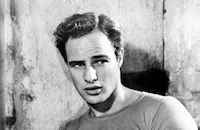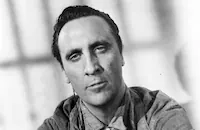With Peckinpah's script, Pennebaker Productions (Brando's film company) approached the young Stanley Kubrick. Brando had been impressed with Kubrick's first two features, Killer's Kiss (1955) and The Killing (1956) and he was convinced that Kubrick was the right man for the job. "We've got to get Kubrick," he is reported to have said. Kubrick agreed to direct but insisted on a new script by Calder Willingham. Karl Malden signed on and the producer, Frank Rosenberg, went to Mexico to search for an actress to play the young love interest. He returned after signing Pina Pellicer for her first film role.
What happened next is less clear. Brando, Kubrick, Willingham, Rosenberg and Carlo Fiore (a friend of Brando's and an assistant on the film) met regularly up at Brando's home overlooking Coldwater Canyon. Brando required that all the men remove their shoes so as not to scratch the wood floor. Kubrick often removed his pants as well, choosing to work in nothing but his shirt and underwear. After many delays and many hours arguing up at Brando's house, Willingham left and was replaced by Guy Trosper. Brando and Kubrick repeatedly clashed over the issue of character development (it's probably safe to assume that Brando wanted more and Kubrick less), but things finally came to a head when Brando overheard Kubrick making a crack about an actress Brando was smitten with. Kubrick was immediately fired, though the official press release stated that he had resigned to work on Lolita.
With filming set to start in a month, Brando volunteered himself for the job of director. Paramount agreed, even though as Brando himself recounted in his 1994 autobiography, "I didn't know what to do." Five days into shooting, Brando was two weeks behind schedule, a neat mathematical trick. With a Method actor at the helm, actors were encouraged to improvise; one Paramount executive dubbed the film "Stanislavsky in the saddle." Stories circulated in the press about Brando's odd behavior (something that continues to this day). He insisted on getting drunk to film a scene in which he was supposed to act drunk, but he got too drunk to act or direct and so he insisted on repeating the process another day. Again he got too drunk to direct or act. Another time, Brando made everyone sit around while he waited for the "right" wave off the Monterey coast. According to the film's producer, Frank Rosenberg, Brando "pondered each camera set up while 120 members of the company sprawled on the ground like battle-weary troops, or gazed at the seals playing in the swelling seas." Throughout all this, Brando kept shooting. They eventually printed close to 250,000 feet of film (the average is 150,000). All this while utilizing the Vista-Vision process, which cost fifty cents a foot! In the end, the film, originally budgeted at $1.8 million, wound up with a price tag of $6 million.
Brando has called One-Eyed Jacks "one of my favorite pictures." But the ending was not what he intended. Brando's original edit of the film ran 4 hours and 42 minutes. He then, as he put it, "got pretty sick of it and turned the job over to someone else." After he walked away from the editing, the studio cut the picture down to a manageable 141 minutes and added a new ending, which was filmed almost a year after principal photography was completed. According to Brando: "I don't feel it's what I set out to do. In my film, everybody lied, even the girl. The only one who told the truth was the Karl Malden character. Paramount made him out to be the heavy, a liar . . . . Now the characters in the film are black and white, not gray and human as I planned them." How much of Brando's version is true is hard to tell as he has a notorious history of bad-mouthing his pictures just as they are about to be released.
This was the third and final pairing of Brando and Malden, marking the end of a memorable working relationship. Katy Jurado (High Noon [1952], Broken Lance [1954]) is terrific as Maria, Malden's wife, and, in her only US film appearance, Pina Pellicer is well cast in the role of Louisa. Sadly, after a brief film career in Mexico, she committed suicide at the age of 24. Slim Pickens is wonderful as the sadistic deputy sheriff. Brando also borrowed two actors from John Ford's stable: Ben Johnson and Hank Worden. And watch for a quick appearance by Elisha Cook Jr.
Brando claimed that he wanted to make a "frontal assault on the temple of cliches." But according to David Shipman, "you'd have to go back to William S. Hart to find a Western hero so lacking in heroic qualities." Indeed, many reviewers found the film oddly cliched itself. Time magazine, for instance, called it "A horse opera" and claimed it was "the usual melodrama of revenge." But the New York Times called it "extraordinary" and claimed, "It is as if it had been jointly directed by John Huston and Raoul Walsh." All reviewers, however, took note of the stunning cinematography by Charles Lang. Lang's use of color and the contrasting locations of Sonora, Mexico and Monterey, California make One-Eyed Jacks an aesthetic treat and well worth another look.
Producer: Frank P. Rosenberg
Director: Marlon Brando
Screenplay: Guy Trosper, Calder Willingham, based on a novel by Charles Neider
Art Direction: J. McMillan Johnson, Hal Pereira
Cinematography: Charles Lang
Costume Design: Yvonne Wood
Film Editing: Archie Marshek
Original Music: Hugo Friedhofer
Principal Cast: Marlon Brando (Rio), Karl Malden (Dad Longworth), Pina Pellicer (Louisa), Katy Jurado (Maria), Ben Johnson (Bob Amory), Slim Pickens (Deputy Lon Dedrick), Timothy Carey (Howard Tetley), Elisha Cook, Jr. (Carvey), Ray Teal (Barney), Larry Duran (Chico), Sam Gilman (Harvey Johnson).
C-142m. Letterboxed.
by Mark Frankel

























